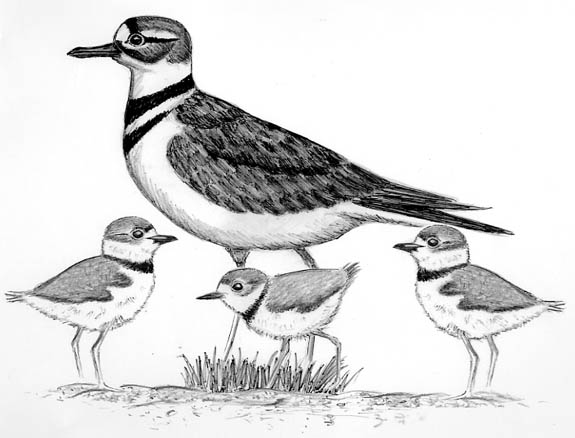
Dear Bird Folks,
While sitting in the car last summer, looking at the mounds of compost on Giddiah Hill Road, in Orleans, we spotted a Killdeer. A few minutes later the Killdeer was approached by two Piping Plovers. The plovers snuggled up against the Killdeer as if they were being brooded. Have you ever seen a Killdeer and Piping Plovers interact like this?
– Susan, Orleans, MA
Sure, Susan,
You and someone else were sitting in a car on a quiet road, looking at mounds of compost, and you want me to believe that it was the birds that were doing all the snuggling. My parents weren’t the most hip people in the world, but I think even they would have been suspicious if I had asked to borrow to car so I could go look at a mountain of compost. But who am I do judge? In this economy maybe looking at compost is all many people can afford to do. Okay, I believe your story, Susan. Yeah, sure I do.
To answer the question: No, I’ve never seen Piping Plovers and Killdeer interacting as you described. And I don’t think you did either. As most beachgoers know quite well, Piping Plovers are birds of the shoreline. They like to be near the water and unlike you, Susan, they are unlikely to be found hanging out near a mound of compost. While pipers and Killdeer often do share the same habitat, they don’t necessarily get along, especially during the breeding season. I have a feeling what you observed last summer was a Killdeer family. The two birds that you thought were Piping Plovers were most likely Killdeer chicks. Piping Plovers are much smaller than Killdeer, so perhaps you thought the chicks were pipers. I could see how you could make that mistake, especially if you were looking through a car window that may have been all steamed up for some reason.
I’m sure many readers aren’t familiar with the Giddiah Hill Road area of Orleans, so let me fill you in. Orleans, one of the Lower Cape’s more picturesque towns, has many beautiful locations, but Giddiah Hill is not one of them. Giddiah Hill is the land of auto body shops, storage containers and dump trucks. No self-respecting Piping Plover would ever call this area home. Killdeer, on the other hand, aren’t quite so snobby. They love the low rent district. While other birds may require the protection of trees and bushes, Killdeer want things to be open, barren and ugly. Giddiah Hill has plenty of all three.
Killdeer, the bird with the name that would make any mass murderer envious, is actually a large plover. It gets its name from the ” killdeer, killdeer, killdeer” alarm call. And as anyone who lives near a nesting Killdeer will tell you, these jittery birds always seemed to be alarmed about something. They are fairly common plovers, found throughout much of North America and most humans enjoy seeing them. In fact, there was even a TV show in the mid sixties about one particular bird called Dr. Killdeer. Remember it?
The Killdeer, like all plovers, are classified as shorebirds. The trouble is, no one has ever bothered telling them that. They are just as comfortable on an inland field as they are near water. In fact, killdeer are on the short list of birds that have benefited from man and our clear-cutting ways. Farms, golf courses, sand pits, dirt parking lots, and even the graveled roofs of factories appeal to this not-too-particular bird. Killdeer lay their eggs on the bare ground, right out in the open, with nothing to hide their exposed eggs but cryptic coloring. But the coloring hides the eggs so well that I’m surprised even the adult birds can find them. And if you think nesting in the open makes their babies easy prey, forget about it. Killdeer have it all planned out.
I think most of us have seen nature shows where a mother bird uses the “broken wing act” to distract a predator. Well, the Killdeer have taken this acting thing to another level. When a predator is spotted the first thing the parent does is sneak off its nest. When it’s a safe distance away the show begins. Starting with a panic-sounding distress call, the “injured” Killdeer stretches out a wing and feebly attempts to fly, but of course doesn’t. It then tries to run away. After only a few feet the bird begins to stumble and stagger, looking like a participant in Boston’s Saint Patrick’s Day parade. Once the Killdeer has drawn the predator well away from the nest it suddenly springs to life and flies away, causing the confused marauder to leave the area shaking its head.
North America has about ten or so different species of plovers, but the Killdeer is the only one with two distinctive black breast-bands. However, Killdeer chicks (this has to do with your question, Susan, so pay attention) have only one breast-band. The adult Piping Plover also has one breast-band. Putting this new piece of evidence into the mix I can easily see why you thought an adult Killdeer was brooding a pair of Piping Plovers. It all makes sense now. I’m sorry I blamed your misidentification on steamed-up windows. It still doesn’t explain your fascination with mounds of compost, but that’s another topic for another time.